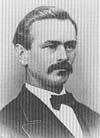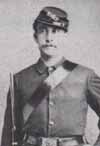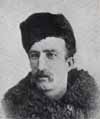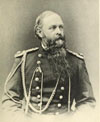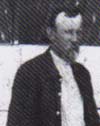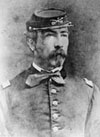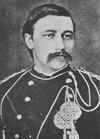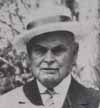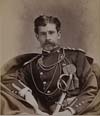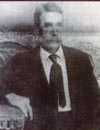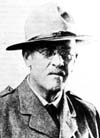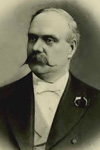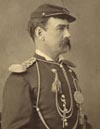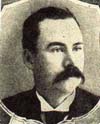John Nolan died on July 17, 1893, in Newburgh, New York. He was a Corporal in Company K who was not present at the battle due to detached service at Powder River, Montana.
Edward Gustave Mathey (left) died in Denver, Colorado, on July 17, 1915, and was buried in Arlington National Cemetery in Arlington, Virginia. He was the First Lieutenant of Company M who commanded the pack train and participated in the hilltop fight.
Jonathan J. Callahan was born on July 18, 1853, in Salem, Massachusetts. He was a Corporal in Company K who was killed with Custer’s Column during the battle.
John B. McGuire, Jr., (left) was born in Livermore, Westmoreland County, Pennsylvania, on July 18, 1854. He was a Private in Company C who rode with the pack train and was wounded in his right arm during the hilltop fight.
Nickolas Klein died on July 18, 1904, in Cleveland, Ohio, and was buried in the West Park Cemetery there. He was a Private in Company F who was not present at the battle due to detached service at Fort Lincoln caring for the company’s property and garden.
Daniel Alexander Kanipe (left) died in Marion, North Carolina, on July 18, 1926, and was buried in the Oak Grove Cemetery there. He was a Sergeant in Company C who was with Custer’s Column and in the hilltop fight.
John Weiss died on July 18, 1927, in Durango, Colorado, and was buried in the Greenmount Cemetery there. He was a Private in Company A who was not present at the battle due to detached service, tending the company garden at Fort Lincoln, Dakota Territory.
Richard Winick Corwine was born in Maysville, Mason County, Kentucky, on July 19, 1844. He was a Private in Company A who was not present at the battle due to detached service at Fort Lincoln, Dakota Territory. He was later killed at Wounded Knee.
David Cooney died on July 20, 1876, at Fort Abraham Lincoln, Dakota Territory. He was originally buried in the Post Cemetery there and was later reinterred in the Custer National Cemetery on the Crow Agency in Montana. He was a Private in Company I who rode with the pack train and was wounded in his right hip during the hilltop fight.
On July 20, 1881, Sitting Bull (left) surrendered to U.S. federal troops.
William August Marshall was born in Germany on July 21, 1851. He was a Private in Company D who participated in the hilltop fight during the battle.
The Minneapolis Tribune reported on July 21, 1882, that “. . . Francis J. Kennedy (right) and Mary E. Hogan . . . received legal permission yesterday to marry.” He was a Private with Company I who was with the pack train and in the hilltop fight.
John A. Reed (left) died on July 21, 1897, at Fort Sisseton, South Dakota. He was originally buried in the Post Cemetery there and was later reinterred in the Custer National Cemetery on the Crow Agency in Montana. He was a Private in Company G who was in the valley and hilltop fights.
John Eaton Tourtellotte (left) died on July 22, 1891, in LaCrosse, Wisconsin. A cenotaph for him is at the Tourtellotte Cemetery in Thompson, Connecticut, but he was buried in Arlington National Cemetery in Arlington, Virginia. He was a Captain in Company G who was not present at the battle due to detached service as an aide-de-camp to General Sherman.
